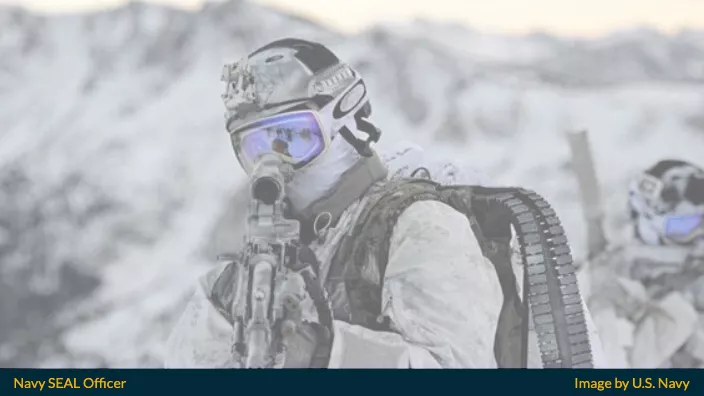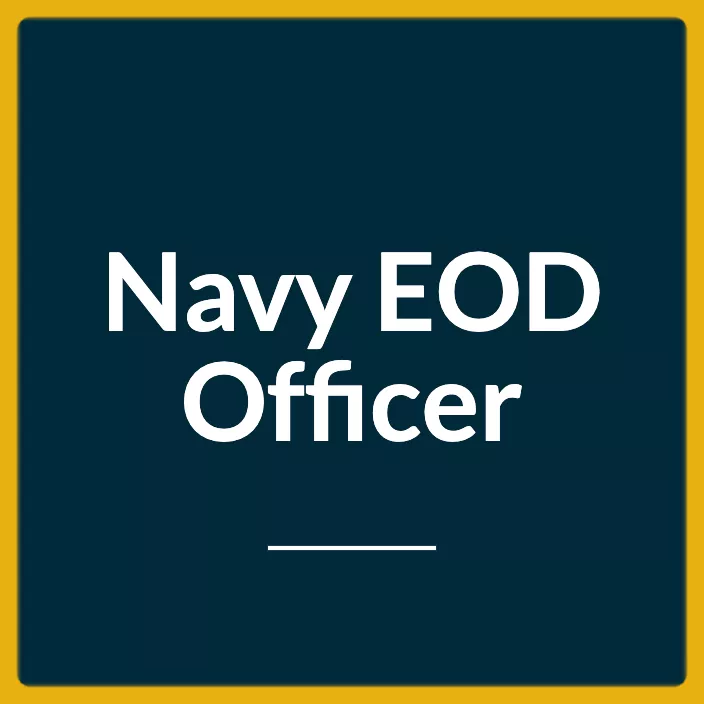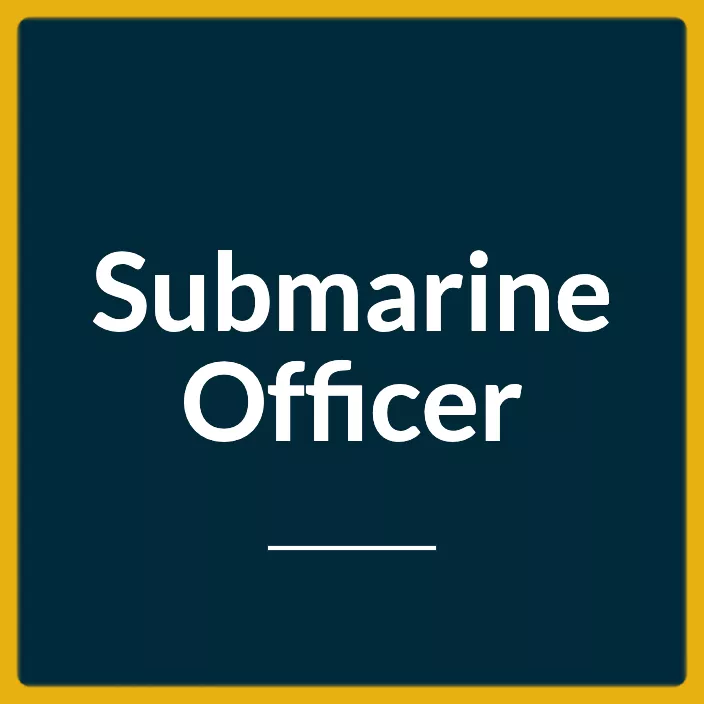Last Updated on October 14, 2024
This guide’s here to give you the info you need to help you decide if you want to be a Navy SEAL Officer in Fiscal Year 2025.
If you’re reading this, it’s probably because you’re highly driven.
Becoming a Navy SEAL is already tough, but you’re looking into how to become a Navy SEAL Officer. Now that’s a whole new level of challenge—and excitement.
A Navy SEAL Officer is an Unrestricted Line Officer in charge of leading the world’s top warriors: the Navy SEAL teams. Their special code is 1130.
So, how do you start on your journey to becoming a Navy SEAL Officer?
Stick around to find out more about the steps to take.
What Does A Navy SEAL Officer Do?

The Navy SEALs are an agile, elite maritime military unit equipped for all facets of unconventional warfare, founded by President John F. Kennedy in 1962.
In this position, you will give critical military assistance in times of crisis all throughout the world.
As a SEAL Officer, your responsibilities may include, but are not limited to:
- Conducting clandestine Special Warfare/Special Operations insertions and extractions by sea, air, or land
- Detecting and apprehending high-value enemy people and terrorists all across the world.
- Special reconnaissance missions are used to gather information and intelligence.
- Small-unit direct-action operations against military objectives
- Prior to amphibious invasions, conducting underwater research and destruction of natural or man-made barriers.
- In your unit, you will be in charge of training and leading enlisted SEALs.
SEALs are not only highly skilled individuals; they are also members of closely knit teams.
They train and work in all sorts of environments. That includes deserts, urban areas, mountains, forests, jungles, and arctic conditions.
A typical mission involves the use of many types of means to enter a combat objective: parachute, submarine, helicopter, high-speed boat, foot patrol, or combat swimmer insertion.
But do not get it twisted, this is mostly a leadership job.
Navy SEAL Officer Pay
In addition to the regular military pay and allowances, the Navy pays out a bonus for joining the Navy Special Warfare community.
This is a combination of regular pay (taxed) and allowances (non-taxed).
In some cases, you may also earn additional pay. For example pay for special duty assignment, parachute jump, dive pay, or demolition pay.
Together with other regular military benefits, these individuals are considered the highest paid Line Officers in the U.S. Navy.
Navy SEAL Officer Career Path
A career as a Navy SEAL Officer starts with being a Navy Officer aspirant from either Navy OCS, NROTC, or the Naval Academy.
This specific career offers unique opportunities and experiences for motivated individuals who want to be challenged in their lives.
As you will see, this is not for the faint of heart.
Also Read: Navy OCS Guide for Officer Applicants
Initial SEAL Officer Training
In highly stressful and high risk situations, Navy SEALs teach enlisted men and officers an unconventional mindset that helps them work as a team, think creatively, and remain alert to threats.
SEALs are now one of the most effective weapons in the global war against terror. This has become well-known even in popular media.
The initial training is conducted in Coronado, CA at Basic Underwater Demolition/SEAL (BUD/S) Training. BUD/S is six months of the most difficult training that the US military offers.
BUD/S is hard… really hard.
Naval Special Warfare Orientation
The Naval Special Warfare Orientation (NSWO) course is 3 weeks long. This is where SEAL officer candidates meet their classmates who are already in the service.
You will get a room in the barracks and get the right gear for your training. Your instructors will show you how to live and work in a special operations training environment, as well as the values of teamwork and perseverance.
In this intensive course:
- You learn how to swim in the ocean and do underwater training in the pool.
- You also learn how to run on the sand with your full gear on.
- Furthermore, you will also learn about Naval Special Warfare (NSW) culture and history.
In NSWO, instructors start the process of only selecting students who have the right character and are excited about achieving great things for the NSW community.
To become a NSW operator, you need to show that you are mentally and physically strong and ready for the work.
If you don’t, the Navy will move you somewhere else.
After this, SEAL officer candidates go to the First Phase of Basic Underwater Demolition/SEAL training (BUD/S).
BUD/S First Phase
The first phase, basic conditioning, lasts 7 weeks and develops the class in physical training, aquatic proficiency, and mental toughness while also fostering collaboration.
You are required to undertake more running, swimming, and calisthenics than the previous week, and your performance is judged by a 4-mile timed run, a timed obstacle course, and a 2-mile timed swim.
In addition, you will learn how to perform hydrographic survey operations in addition to physical training.
Hell Week is the fourth week of the First Phase of BUD/S.
During this arduous five-and-a-half day period, you will only get around 4 hours of sleep and will be required to exercise for more than 20 hours every day.
By the end of the week, you will have logged more than 200 miles.
Every candidate will physically collapse, but you will succeed if you have the mental courage to fight through your apparent limits and commit to the team.
Hell Week is the ultimate test of willpower.
Those who succeed move on to the Second Phase, Combat Diving.
Combat Diving
The combat diving phase lasts 7 weeks in the second phase. This phase teaches Navy SEAL-specific underwater abilities.
SEAL Officer trainees acquire fundamental combat swimming skills, as well as open and closed-circuit diving.
During this phase, you must be able to execute in challenging and frequently unpleasant circumstances and display a high degree of comfort in the water.
Reality check: you may struggle to succeed if you are not entirely comfortable in the water.
Those who perform well will advance to the Third Phase, Land Warfare.
Land Warfare
Land warfare is the third phase, which lasts 7 weeks and teaches you basic weaponry, land navigation, demolitions, marksmanship, rappelling, patrolling, and small-unit tactics.
The days get longer and more rigorous over the final 3 and a half weeks of training, mirroring the work hours spent in the field.
You will be taught how to acquire and process data in order to achieve the overall task.
More classroom work is required to teach map, compass, land navigation, and basic weapon skill sets.
These skill sets enable you to progress from being a novice to being more comfortable in the field. The majority of this instruction is new, and the learning curve is steep.
The third phase establishes the groundwork for the remainder of Navy SEAL training.
You will employ these fundamental move-shoot-communicate abilities in SEAL Qualification Training (SQT) and on SEAL Teams.
Those who make it to the Third Phase have shown an uncommon dedication to become a Navy SEAL Officer.
SEAL Qualification Training
SEAL Qualification Training (SQT) is a 26-week school that progresses the student from basic Naval Special Warfare training to a more advanced level of tactical training.
SQT is intended to equip students with the fundamental tactical understanding required to join a SEAL team.
You will participate in Survival, Evasion, Resistance, and Escape (SERE) training and parachuting before graduation, including static-line and free-fall missions at high and low altitudes.
SQT includes the following:
- Weapons training
- Demolitions
- Cold weather training
- Land navigation
- Small unit tactics
- Maritime operations
- Medical skills
After meeting these requirements, you will be given your SEAL Trident warfare designator and assigned to a SEAL team to begin training for your first deployment.
Follow-On SEAL Officer Training
Graduates of BUD/S must then attend four months of highly-paced, advanced tactical training known as SEAL qualification training. This is when SEALs earn their Trident.
Having recently earned their Tridents from SEAL qualification training, a select small number of new enlisted SEALs will attend 18 Delta SOF Medicine Course at Ft. Bragg, North Carolina, and a few others will continue their training in Panama City, Florida, in order to become SEAL delivery vehicle operators.
A large group of them will go directly to one of the SEAL teams on the east or west coast to begin platoon training. They will learn what is called ‘the real deal’, which is training to fight in battle.
SEAL Officers will, on average, manage two platoons of their own on their first team. Formation of a platoon and deployment to another country typically takes 18-24 months. The process includes training, deployment, and stand down phases.
Navy SEAL Officer Career Progression
As a SEAL officer, you will typically go straight to a SEAL team or SEAL Delivery Vehicle (SDV) team for your first operational tour.
After that, you will also go overseas for two years, to train and workup, and for overseas deployments. Your second assignment will probably be with a SEAL team if your first assignment was with an SDV team.
You will be the assistant platoon commander for a platoon whose leader is the Assistant Officer-in-Charge (AOIC). You will be an officer-in-charge (OIC) on your second two-year tour of duty.
Specialized training available to SEAL Officers includes Sniper, Freefall Jumpmaster, Dive Supervisor, Recall Master, Fast Rope Master, etc. Demolition, cleaning, loadmaster, rigger, hazardous cargo certifier, and outboard motor maintenance are only available to enlisted personnel.
Your third tour of duty will be Shore Duty on a Staff assignment, in language school, or at the Naval Postgraduate School in Monterey, CA.
As an alternative, you may qualify for a billet to complete the Phase I requirements of the Joint Professional Military Education (JPME) by attending one of the four U.S. Military War Colleges in the junior courses.
Next, you will go back to an operational command for a tour, then alternate staff and operational tours.
In the majority of cases, the career path for SEAL Officer looks like this:
(O-3) Lieutenant or (O-4) Junior Lieutenant Commander
- Operations Officer at a SEAL or SDV Team or equivalent
(O-4) Senior Lieutenant Commander – Executive Officer
- Executive Officer of a SEAL team or a SDV team
(O-5) Commander – Commanding Officer
- Commanding Officer of a SEAL, SDV or Special Boat Team
(O-6) Navy Captain – Major Command
- Naval Special Warfare Group or Naval Special Warfare Development Group Commander
(O-6) Navy Captain – Staff Position
- Pentagon staff officer or Deputy Commander of a Special Operations Command in a theater.
The above is just an example of the tours that take an Ensign (O1) to Navy Captain (O-6). It can take 20 years to complete this journey.
But remember:
You are unique, regardless of the career path that you choose. You’ll have to find your own path for your own career.
The Navy assigns jobs based on their performance, timing of the rotation, and number of available billets, among many other factors.
(Source: navyseals.com)
Navy SEAL Officer Requirements
These positions must be filled with honorable and visionary men who can represent the nation well overseas.
Applicants should be committed to the Navy Special Warfare Community, its mission and its people.
To become a Navy SEAL Officer, you must be an American citizen no older than 42 years old with at least an undergraduate degree from an accredited institution and must be physically fit enough to pass the specialized medical exam and the Physical Screening Test.
To succeed as a leader in the SEAL teams, one must possess the following qualities: leadership, integrity, courage, teamwork, drive, and an unwavering commitment to excellence despite all obstacles.
Basic Eligibility for Navy SEAL Officer
1) Citizenship
SEAL Officer applicants must be citizens of the United States.
2) Age
Applicants must be at least 25 years old and not have passed their 42nd birthday at the time of commissioning. (Current Navy SEAL Officer Age Limit as of FY 2024)
3) Education
Applicants must have a baccalaureate degree from a regionally accredited institution. Candidates may apply during their Senior year in college.
4) Physical
The Navy Bureau of Medicine and Surgery will determine whether the individual is medically eligible. If eligible, a letter will be generated stating that the applicant is physically qualified for “special operations and diving” duty.
5) Physical Screening Test
SEAL Officer applicants must be able to pass a physical screening test (PST) in accordance with SEAL Physical Screening Testing Standards and Procedures, MILPERSMAN 1220-410.
Physical Screening Test
This physical screening test (PST) is intended to test your overall physical readiness for entering the challenging Navy Special Warfare and Special Operations Training Pipelines.
Remember:
Everyone who entered BUD/S passed the PST to get there, and almost half of them do not finish BUD/S.
Minimum PST Scores
SWIM: 500 YDS. Side stroke/breast stroke 12:30 min
PUSH-UPS: (within 2 min) 42
SIT-UPS: (within 2 min) 50
PULL-UPS: (no time limit) 6
1.5 MILE RUN: 11:00 min
Competitive PST Scores
SWIM: 500 YDS. Side stroke/breast stroke 10:30 min
PUSH-UPS: (within 2 min) 79
SIT-UPS: (within 2 min) 79
PULL-UPS: (no time limit) 11
1.5 MILE RUN: 10:20 min
Selection Process for Navy SEAL Officer
Applicants who desire to become SEAL officers must be selected by the SEAL Officer Selection Panel and provide current contact information to the SEAL Officer Community Manager’s office.
Active Duty applicants that do not hold the NECs O26A, O23A or O52A must attend SEAL Officer Assessment and Selection (SOAS).
If they are unable to attend due to operational commitments, applicants must conduct an interview with SOAS staff members.
Active Duty applicants previously disenrolled from Basic Underwater Demolition/SEAL Training through a voluntary drop on request are not eligible to attend SOAS.
All civilian applicants must attend SOAS to be considered by the selection panel, unless specifically approved for consideration by the Naval Special Warfare Program Manager.
If you are interested in becoming a Naval Special Warfare SEAL Officer, you must begin the application process by completing NAVPERS Form 1210/9 and sending that to SEAL_Apply@navy.mil.
Complete the rest of the application as per the following application guidelines and deadlines.
Applications for SEAL Officer Assessment and Selection are typically due in February every year. Yes, there is only one selection board per year.
Navy SEAL Officer Application Calendar
1. February – Applications for all candidates other than active duty SO and SB enlisted members are due to SEAL_apply@navy.mil.
2. March – Down select panel narrows down eligible applicants. Selected candidates from this panel are invited to attend SEAL Officer Assessment and Selection (SOAS).
3. June – Enlisted SO and SB application packages are due to SEAL_apply@navy.mil.
4. June, July, August – SOAS takes place in three different sessions during the Summer in Coronado, CA.
5. September – The SEAL Officer Selection Panel convenes to select candidates who will begin Basic Underwater Demolition / SEAL (BUD/S) training during the subsequent fiscal year.
Navy SEAL Officer Application Contact Information
SEAL Officer Community Manager (Applications)
SEAL_apply@navy.mil
(703)-604-5063
SOAS Program Manager
SOASPM@SEALSWCC.com
(888)-633-5460; (619)-537-1149 (Mon – Wed)
More Information
If you want more information about becoming a Navy SEAL Officer, the next logical step is to contact a Naval Officer Recruiter.
Let’s start figuring out how you can benefit from becoming a Navy SEAL Officer – or if it’s even the right career move for you.
You may also find more information about other closely related Navy Officer jobs in our Quick Guide for Unrestricted Line Officer programs, such as the Navy EOD Officer program. Check it out.

